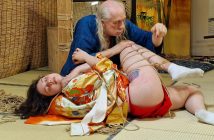Pictures from Hell
Ito Seiyu (1882-1961) has been pushing the envelope of kinbaku and torture imagery long before the “Golden Age” of SM magazines, getting some of his better work censored and banned by the authorities, earning him the label of “pervert”.
To help you better appreciate this series, first read the following notes on the kanji characters heading each picture and text:
Wood (木, ki), Fire (火, hi), Earth (土, tsuchi), Metal (金, kin), and Water (水, mizu) are the “five elements” called Wu Xing (五行) in Chinese. The concepts of Wu Xing can be found anywhere from acupuncture to feng shui (geomancy) to martial arts, and even apply to tea ceremony.
Sun (日, hi) and Moon (月, tsuki) plus the five Wu Xing elements also correspond to the days of the week.
There goes hardly a description of beauty that doesn’t include the combination of the three kanji characters for Snow (雪, yuki), Moon (月, tsuki), and Flower (花, hana). This combination even has its own name: setsu getsu ka (雪月花). Pls note that setsu is another reading for yuki (雪), getsu is another reading for tsuki (月), and ka is another reading for hana (花).
Now, let’s cut to the chase and enjoy the first installment.
Sun
Every village has its own laws. If strangers are caught stealing food, they will be exposed for three days at the village’s outskirts. Famished orphans sometimes wander into a village and take food without thinking. If they are caught, villagers will take the law into their own hands and render harsh punishment. It is the ultimate misery.
日 (hi)
村内の掟ありて野菜果実を盗む他村の者は之や捉へて三日間村端れに曝すといふ。行路の孤児餓えて無意識に之や盗み喰ふ。時に村人の発見する所となり掟以上の私刑を加へらる。慘の極なり。
Moon
Before the war in Shimabara*, many Christians were persecuted. Lord Matsukura Shigenaga was a sexual pervert. He captured women, committed atrocious torture, and then threw them into the snake valley at the corner of Mount Unzen.
The crescent moon shines on dead bodies, where poisonous snakes slither and wolves feast on human flesh. What is a real inferno, if this picture doesn’t show it?
*Referring to Shimabara no ran (the Shimabara Rebellion), which was a major uprising in southwestern Japan in the 17th century.
月 (tsuki)
島原の戦前、異敬徒の迫害せらるる者多し。領主松倉重長は変態性慾者なりき。婦女をとらへて慘虐なる拷問を行ひ、雲仙獄の一角、蛇谷に投ず。
弦月死屍を照し、毒蛇射狼人を噛む。真にこれ一幅の地獄図繪に非ずして何ぞや。
Fire
During the Sengoku period*, humanity was entirely lost. Fathers, sons, and brothers were killing each other. All beautiful women left in fallen castles were subjected to gruesome torture. Those who have the power, use it to rule; while those who have lost the war are left with nothing. At the war of the Meiji Restoration, many women inside the Aizu castle killed themselves after being raped by the ruling army. Those who achieved victory might hold the power, but that doesn’t make them just. Ah!
*The Warring States Period in Japanese history from the middle of the 15th century to the beginning of the 17th century.
火 (hi)
戦国時代、父子兄弟相食み、人道地に墜ちたり。城陥りて城内の麗人悉く惨虐の刑罰の的となる。勝てば官軍、負くれば賊。明治維新の戦に、会津城内の婦女辱めに遇ひて自害せし者多し。 官軍必しも正義人道の人に非ず。鳴呼。
Water
A woman is never far from jealousy. Punishment for beautiful women who are favored by married men includes various kinds of water torture. Sometimes, they are dunked mercilessly underwater after being whipped and beaten. Sometimes, they are drenched in water on cold nights or locked inside water-filled chambers. The most appalling of it all is to be bound to rotating waterwheels. This is torture of hell.
水 (mizu)
女に嫉妬は附物なれば、殿の寵を専にしたる美女が鞭苔に次で水資の惨刑を説せられて水底に葬られ、或いは寒夜水に浸さるるもの、水牢の刑を受くるもの、その最も酸鼻なるは水車に縛して回轉するもの等々にしてこれ亦地獄の責苦なり。
Wood
Hihi* monsters are living in trees. Many legends tell about young virgins of unequaled beauty being offered as sacrificial victims to old cedar trees with thick and dark foliage, in order to protect villages from disasters. Iwami Jyutaro is known as a hihi slayer, but perhaps a hihi is some kind of a bandit.
*A hihi is a fabled monster that looks like a giant monkey. These beings are believed to have lived in mountains and attacked women, often demanding human sacrifice.
木 (ki)
樹の怪あり。怪の樹に棲むあり。老杉鬱々たる頭、絶世の美女、人身御供となりて一村の災厄を免れしめんとすることに伝説多し。拂々退治といへば岩見重太郎を連想すれども、拂々とは或は山賊の類ならんか。
Metal
The golden age is not the product of the Taisho and Showa periods only. It is said that love potions from Sado work best*. Surrounded by policemen, thieves cut their bellies and scatter stolen gold from the top of a tower. Can the policemen take this gold, or does it become property of the commander and the Shogunate? Who knows where such dirty money goes.
*This proverb means that coins minted from gold of the Sado Kinzan mine work better than any other love potion.
金 (kin)
黄金時代は唯に大正、昭和の産物に非ず。『惚れ薬佐渡から出るが一ツち利き』賊となつて捕手に圍まれ、塔上に腹を裂いて奪ふところの黄金を撒く。知らず捕手の所得か、将又幕府の所得か。不浄金の行方や知るよしもなし。
Earth
Even Kashima’s kaname-ishi* stone loses its effect over time. We can study the cause of an earthquake and announce its epicenter after it happened. Yet, this doesn’t stop an earthquake. A loyal warrior, Fujita Toko** was crushed to death under falling beams, while trying to save his mother. It is the most regrettable event in a thousand years. When can we ever escape from this living hell?
*The keystone of Kashima Jingu shrine, which is believed to have the power of preventing earthquakes.
**A renowned scholar from the Mito domain, who died during the Ansei Edo Earthquake in 1855.
土 (tsuchi)
鹿島の要石も後世には利き目なし。地震の後に原因を探り、震源地を発表するも何ぞ夫れ及ばんや勤王の志士藤田東湖も親を救はんとして梁に打たれて死す。千載の恨事ならん。これ文字通りの地獄にして、いつの日かこの厄を免れんや。
Snow
With no regard for human rights, Edo’s pleasure quarters and the institution of slavery created a kind of punishment called snow torture. What we see in theater at the Yamanaya scene from Ake garasu yume no awa yuki* was nothing out of the ordinary at brothels in old times. Now that licensed prostitution is totally abolished, we should be glad that such torture is no longer practiced.
*The kanji characters literally mean “morning crows dream frothy snow”. It was originally the title of a famous song from the Shinnai reciting tradition based on a real story of a couple who committed double suicide. The second half of the song is a detailed description of snow torture. The song was later adapted for various other song traditions and theater forms such as Kabuki.
雪 (yuki)
人權無視奴隷主義の江戸遊廓及び奴制度は雪責といふ私刑を作れり。演劇の舞台に見る『明鳥夢泡雪』山名屋の段の如きは昔時の妓樓に在りては日常さはんじのお行事にして異とするに足らず。今や公娼制度の全廃と共にこのことなし。慶すべし。
Moon
There is a delta sandbank of the Sumida River at its midstream called Mitsumata. A governor of Sendai, Lord Date Yorikane bought Takao Dayu* from Miuraya and made advances to her. However, she did not reciprocate, and thus, was beheaded on a boat. This is the so called “suspension slash of Takao.” Meanwhile, another story tells that Takao arrived in Sendai with the lord and lived there well into her 80s. Perhaps, Takao’s stories are mixed with a case of Usugumo Dayu** from Yoshiwara***, who had refused a lord so-and-so, and as a result, was murdered after having her fingers cut off one by one over a period of ten days.
*Takao Dayu is the name of a legendary tayu (the highest-ranking courtesan) in the Edo period. There were many generations of tayu with the same name.
**Usugumo Dayu is the name of another legendary tayu, or of many generations of them.
***Yoshiwara was a famous pleasure district in Edo (present-day Tokyo), which was licensed by the government.
月 (tsuki)
隅田川の中流中洲のデルタを三ツ股と称す。仙台の太守伊達賴兼公、三浦屋の高尾太夫を購ひ、之を挑めも應ぜず、船中にて 之を殺す。世に言ふ『高尾の吊るし切り』はこれなり。或いは言ふ、高尾仙台公に伴われて仙台に到り八十余歳の壽を保つと。思ふに当時吉原の遊女薄雲太夫が 大名某候を嫌悪して、十日に十指切りて慘殺されたる事蹟を混同したるものか。
Flower
It is rare to find words for a beautiful woman that do not include allusions to flowers. Albeit not as beautiful as a keisei*, even a meshimori can turn a jinya. ** One should know that there are specific manners for how to be with an oiran*** of the tayu profession. Nowadays, young men know only of prostitutes, but not about a keisei of Yoshiwara. Nothing remains of that culture, except for what is secretly kept in Shimabara**** of Kyoto.
*Literally meaning “a castle turner,” keisei (傾城) refers to a woman so glamorous that she can ruin a castle by captivating its lord with her beauty.
**Meshimori (飯盛) were hired by inns as maids and often engaged in prostitution. The quote indicates that a beautiful meshimori can bankrupt at least a jinya, an inn designated for feudal lords, if not a castle like a keisei can.
***High-ranking courtesans of Yoshiwara were called oiran (花魁).
****The three major licensed pleasure districts in the Edo period were Shimabara in Kyoto, Shinmachi in Osaka, and Yoshiwara in Edo (present-day Tokyo).
花 (hana)
花の顔、解語の花、欝柳折花。美人の形容花に非ざるもの稀なり。『飯盛も陣屋位は傾ける』傾城ざるも太夫職の花魁なるものに權式ありやを知るべし。現代の青年、売笑婦を知りてよしわらの傾城を知らず。今きょうとの島原に密かに其の形骸を留むるのみ。














1 Comment
Dear Sensei
Thank you for sharing this marvellous Ito Seiyu´s series of pictures with us. I really miss your guidance and I´m looking forward to seeing you in Tokyo again this year.
Send you some summer flower breeze form Buenos Aires,
Tsubaki